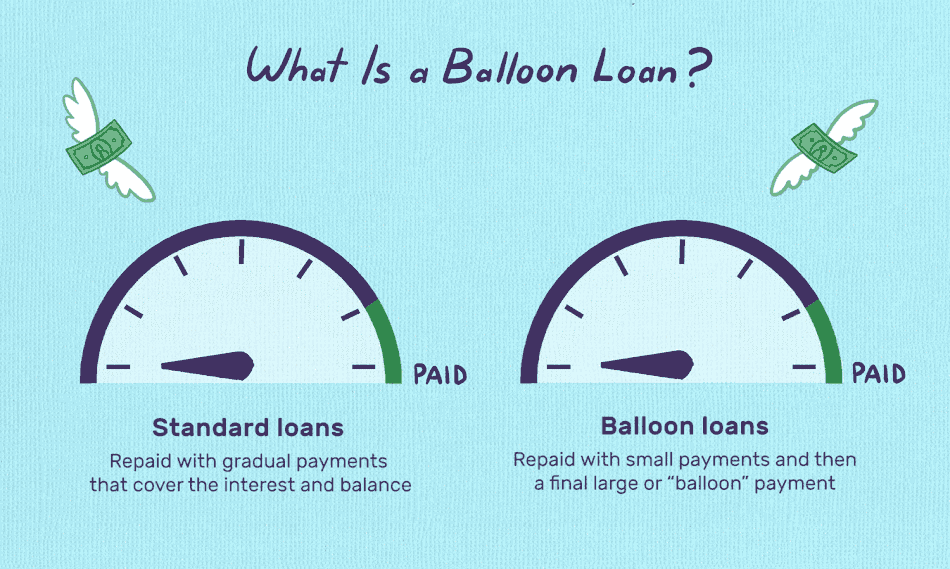A balloon loan is a type of loan where you make relatively small monthly payments during the loan term, but at the end of the term, you owe a large lump sum payment called the “balloon payment.” Unlike traditional loans that are fully paid off with equal monthly installments, a balloon loan’s monthly payments often cover only part of the loan’s principal, or sometimes just the interest, which means you still owe a big chunk of the loan amount when the loan term ends.
For example, you might have a loan where you pay monthly for five years, but the payments are calculated as if you were paying off the loan over 30 years. At the end of those five years, you owe the remaining balance all at once—the balloon payment.
Balloon loans can be helpful if you expect your income to increase, plan to sell the asset, or refinance the loan before the balloon payment is due. However, they carry risks, especially if you’re unable to make the big final payment when it comes due.
In the realm of personal and business financing, the term “balloon loan” often surfaces as a viable option for borrowers seeking lower initial payments. However, the allure of reduced early costs can overshadow the substantial risks and complexities associated with balloon loans. This article delves into the intricacies of balloon loans, examining their structure, advantages, disadvantages, and providing guidance to determine if they align with your financial objectives.
Key Takeaways
- Lower Initial Payments: Balloon loans offer reduced monthly payments during the loan term.
- Large Final Payment: A substantial balloon payment is due at the end of the loan term.
- Refinancing Risks: Changes in market conditions or personal finances can complicate refinancing.
- Slow Equity Building: Minimal principal repayment can result in slower equity accumulation.
- Not for Everyone: Balloon loans are best suited for borrowers with a clear exit strategy and the ability to manage the final payment.
In summary, while balloon loans can provide short-term financial relief, they require careful planning and a solid understanding of the associated risks. Always consult with a financial advisor to determine the best financing option for your circumstances.
Understanding Balloon Loans
A balloon loan is a type of loan that does not fully amortize over its term. Instead of making equal monthly payments that cover both principal and interest, borrowers make smaller payments throughout the loan term, with a large lump sum—known as the “balloon payment”—due at the end. This structure results in lower monthly payments compared to traditional loans but requires the borrower to pay off the remaining balance in one substantial payment at the loan’s maturity.
Balloon loans are commonly used in various sectors, including real estate, automotive financing, and business loans. They are particularly appealing to borrowers who anticipate an increase in income or plan to sell the asset before the balloon payment is due.
Types of Balloon Loans
Balloon loans are a type of financing with a distinct structure—smaller payments over the life of the loan followed by a large, final “balloon” payment at maturity. While the basic concept remains the same, balloon loans can vary significantly based on the context in which they’re used. Understanding the different types of balloon loans can help you choose the right option based on your financial goals and risk tolerance.
Here are the most common types of balloon loans:
Balloon Mortgage Loans

A balloon mortgage is a home loan where the borrower pays relatively low monthly payments for a short period—usually 5 to 7 years—after which the entire remaining balance of the loan is due as a lump sum. These mortgages typically use a 30-year amortization schedule to calculate the monthly payments, but the full loan becomes due far earlier.
Ideal for:
- Buyers planning to sell or refinance before the balloon payment is due.
- Borrowers expecting higher income in the near future.
Risks:
- Housing market downturns can prevent the sale or refinancing.
- Rising interest rates may make refinancing expensive.
Interest-Only Balloon Loans
This variation allows the borrower to pay only interest on the loan during the term. None of the monthly payments reduce the principal, so the entire original loan amount becomes the balloon payment at the end of the term.
Ideal for:
- Investors who anticipate high returns before the balloon payment is due.
- Borrowers needing minimal monthly payments temporarily.
Risks:
- No equity is built during the term.
- Full principal must be paid off or refinanced at maturity.
Commercial Balloon Loans
In business financing, commercial balloon loans are often used to purchase equipment, real estate, or fund operations. These loans may span 5 to 10 years with amortization periods of 15–30 years, requiring a balloon payment when the term ends.
Ideal for:
- Businesses expecting increased future revenue or capital influx.
- Companies that plan to sell the asset or refinance.
Risks:
- Business downturns can make it hard to refinance or pay off the balloon.
- Commercial real estate values can fluctuate, affecting refinancing options.
Auto Balloon Loans
An auto balloon loan is structured similarly to a balloon mortgage but applied to car financing. You pay lower monthly payments throughout the loan and a large final amount—sometimes called a “residual value”—at the end. Some lenders offer refinancing or return options at the balloon stage.
Ideal for:
- Buyers who want a more affordable car in the short term.
- People who plan to trade in or return the vehicle before the balloon payment.
Risks:
- The car may depreciate faster than expected.
- You may not be able to cover the balloon or qualify for refinancing.
Land or Lot Balloon Loans
When purchasing vacant land, especially for future construction, balloon loans are often used. The borrower makes interest-only or low monthly payments for several years until a balloon payment becomes due.
Ideal for:
- Property investors or future builders.
- Buyers who plan to develop and refinance with a construction loan.
Risks:
- Property value may not increase as expected.
- Development delays can hinder refinancing plans.
Balloon Loans for Equipment Financing
Small and medium businesses often use balloon loans to finance equipment purchases. These loans help preserve cash flow by keeping initial payments low, with the expectation that the equipment will help generate revenue by the time the balloon payment is due.
Ideal for:
- Companies needing equipment immediately without large capital outlay.
- Businesses projecting stronger cash flow in the near future.
Risks:
- Equipment may become obsolete before the loan is paid.
- Business income may not increase as projected.
Hybrid Balloon Loans
Some loans combine aspects of balloon and adjustable-rate loans. For example, a loan may start with a fixed low interest rate and regular payments, followed by a balloon payment, or it may include options to refinance automatically if criteria are met.
Ideal for:
- Borrowers needing temporary payment relief but unsure of future refinancing options.
- Those who want more flexibility than a standard balloon loan.
Risks:
- Terms can be complicated.
- Not all borrowers qualify for automatic refinancing options.
Summary of Balloon Loan Types
| Type | Use Case | Payment Structure | Key Risk |
|---|---|---|---|
| Balloon Mortgage | Home purchase | Low monthly + large final payment | Market risk, refinancing challenges |
| Interest-Only Balloon | Investment or short-term need | Interest only, full principal due later | No equity built, large final bill |
| Commercial Balloon | Business financing | Low monthly + large end balance | Business volatility |
| Auto Balloon | Car buyers | Smaller monthly + big final (residual) | Car depreciation |
| Land or Lot Balloon | Land purchases | Low payments + final payoff | Construction delays |
| Equipment Financing Balloon | Business equipment | Small payments + large balloon | Equipment value drop |
| Hybrid Balloon | Mixed scenarios | Varies by agreement | Complex terms |
How Balloon Loans Work
A balloon loan works differently from traditional fully amortizing loans. Instead of spreading out the full repayment of the principal and interest evenly across the loan term, a balloon loan features lower monthly payments—typically covering only interest or a small portion of the principal—followed by a large lump sum payment (the “balloon payment”) due at the end of the term.
This structure makes balloon loans attractive in the short term, but they come with significant financial risk if the borrower isn’t prepared to handle the final payment.
Basic Structure of a Balloon Loan
Here’s how a typical balloon loan is set up:
- Loan Amount: You borrow a certain amount (e.g., $100,000).
- Term: The loan might have a short term, such as 5 to 7 years.
- Amortization Schedule: Even though the term is short, payments are based on a longer amortization period—often 15 to 30 years.
- Monthly Payments: You make lower monthly payments during the loan term because you’re not paying off much (or any) of the principal.
- Balloon Payment: At the end of the loan term, the remaining balance of the principal becomes due all at once.
Example of a Balloon Loan
Suppose you take out a balloon loan of $150,000 for 5 years, with payments based on a 30-year amortization:
- Your monthly payments might be around $900, which mainly covers interest and a small portion of principal.
- At the end of 5 years, you might still owe around $140,000.
- That $140,000 becomes your balloon payment, due in full immediately.
Interest-Only Balloon Loans
Some balloon loans are interest-only, meaning:
- You pay only the interest on the loan each month.
- None of the monthly payments go toward reducing the principal.
- When the loan term ends, the entire original loan amount is still owed as a balloon payment.
Common Uses of Balloon Loans
Balloon loans are often used in:
- Real estate (balloon mortgages): Buyers get lower payments early on, planning to sell or refinance the home before the balloon payment is due.
- Auto financing: Some car buyers use balloon loans to keep monthly payments low with the plan to trade in or sell the car before paying the balloon.
- Business loans: Companies may use balloon loans for working capital or equipment purchases, expecting future cash flow to cover the balloon.
Refinancing the Balloon Payment
Most borrowers do not intend to make the balloon payment in cash. Instead, they:
- Refinance the loan before it matures—replacing it with a new loan.
- Sell the asset (like a home or vehicle) to cover the balloon amount.
- Use savings or investment returns to make the final payment.
Refinancing depends on factors like your credit score, income, debt level, and interest rates at the time of refinancing. If any of these are unfavorable, refinancing might be difficult or more expensive.
Risks Involved in How Balloon Loans Work
- Balloon payment shock: Borrowers may not realize how large the final payment will be until it’s due.
- Market risk: You may not be able to sell the asset at a high enough price to cover the balloon.
- Refinancing risk: If interest rates rise or your financial situation worsens, you might not qualify for refinancing.
- Foreclosure or repossession: If you can’t make the balloon payment, you could lose the asset.
How to Prepare for a Balloon Loan
If you’re considering a balloon loan, plan for the balloon payment from the beginning:
Set aside funds or build a balloon payment reserve over time.
Create a detailed payoff or refinancing plan.
Monitor the value of the asset (especially important in real estate).
Regularly check your credit score to ensure you can refinance if needed.
Advantages of Balloon Loans
- Lower Initial Payments: The primary appeal of loans is the significantly lower monthly payments during the loan term. This can be advantageous for borrowers who expect their financial situation to improve in the near future.
- Increased Borrowing Capacity: Due to the lower monthly obligations, borrowers might qualify for larger loan amounts than they would with traditional loans, enabling them to purchase more expensive assets.
- Short-Term Financing Solution: Balloon loans can serve as a short-term financing solution for borrowers who plan to sell the asset or refinance before the balloon payment is due.
Disadvantages of Balloon Loans
- Large Final Payment: The most significant drawback is the substantial balloon payment due at the end of the loan term. If the borrower is unable to make this payment, they may face foreclosure or the need to refinance under potentially less favorable terms.
- Refinancing Risks: Borrowers often plan to refinance the loan before the payment is due. However, changes in market conditions, interest rates, or the borrower’s financial situation can complicate or prevent refinancing.
- Slow Equity Building: Since balloon loans often involve interest-only payments or minimal principal repayment, borrowers may build equity in the asset more slowly compared to traditional loans.
- Potential for Negative Equity: If the asset depreciates faster than anticipated, the borrower might owe more than the asset’s current value, leading to negative equity.
- Complexity and Understanding: loans can be complex, and borrowers may not fully understand the implications of the large final payment, leading to financial strain.
Is a Balloon Loan Right for You?
Determining whether a balloon loan is a smart financial move depends on individual circumstances and financial goals. Consider the following factors:
- Financial Stability: Do you have a stable and predictable income? Can you anticipate the ability to make the balloon payment when it comes due?
- Asset Depreciation: Will the asset retain its value, or is there a risk of depreciation that could lead to negative equity?
- Exit Strategy: Do you have a clear plan to sell the asset or refinance the loan before the balloon payment is due?
- Risk Tolerance: Are you comfortable with the risks associated with balloon loans, including the possibility of foreclosure if the balloon payment cannot be met?
If you answer “yes” to these considerations, a balloon loan might be a viable option. However, it’s crucial to approach such loans with caution and thorough understanding.
Also Read: Are Fast Loans Safe or Risky?
Conclusion
Balloon loans can be a smart financial move for certain borrowers, particularly those who have a clear plan to manage the large final payment. However, they carry significant risks, and it’s essential to fully understand the terms and implications before proceeding. Careful consideration of your financial situation, market conditions, and long-term goals is crucial in determining whether a balloon loan aligns with your needs.
FAQs
- What is the primary benefit of a balloon loan? The main advantage is the lower monthly payments during the loan term, which can ease cash flow for borrowers.
- What happens if I can’t make the balloon payment? If the balloon payment cannot be made, the borrower may need to refinance, sell the asset, or face foreclosure.
- Are balloon loans suitable for long-term financing? Generally, balloon loans are not ideal for long-term financing due to the large final payment. They are better suited for short-term needs.
- Can I refinance a balloon loan? Refinancing is possible but depends on factors like market conditions, interest rates, and the borrower’s financial situation.
- Do balloon loans have higher interest rates? Balloon loans may have higher interest rates compared to traditional loans, reflecting the increased risk to lenders.
- Is the balloon payment always due at the end of the loan term? Yes, the balloon payment is typically due at the end of the loan term, unless the loan is refinanced or the asset is sold.
- Can I pay off loan early? Many loans allow for early repayment without penalties, but it’s essential to review the loan agreement for any prepayment clauses.


